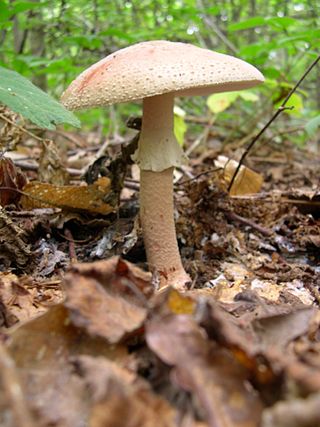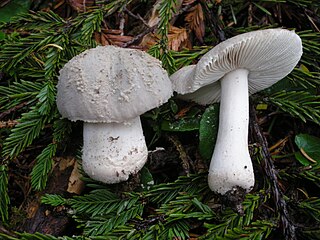
Amanita muscaria, commonly known as the fly agaric or fly amanita, is a basidiomycete of the genus Amanita. It is a large white-gilled, white-spotted, and usually red mushroom.

The genus Amanita contains about 600 species of agarics, including some of the most toxic known mushrooms found worldwide, as well as some well-regarded edible species. The genus is responsible for approximately 95% of fatalities resulting from mushroom poisoning, with the death cap accounting for about 50% on its own. The most potent toxin present in these mushrooms is α-Amanitin.

Amanita fulva, commonly called the tawny grisette or the orange-brown ringless amanita, is a basidiomycete mushroom of the genus Amanita. It is found frequently in deciduous and coniferous forests of Europe, and possibly North America.

The blusher is the common name for several closely related species of the genus Amanita. A. rubescens, or the blushing amanita, is found in Europe and eastern North America, and A. novinupta, also known as the new bride blushing amanita, is found in western North America. Both their scientific and common names are derived from the propensity of their flesh to turn pink upon bruising or cutting.

The Polyporaceae are a family of poroid fungi belonging to the Basidiomycota. The flesh of their fruit bodies varies from soft to very tough. Most members of this family have their hymenium in vertical pores on the underside of the caps, but some of them have gills or gill-like structures. Many species are brackets, but others have a definite stipe – for example, Polyporus badius.

Amanita gemmata, commonly known as the gemmed amanita or the jonquil amanita, is an agaric mushroom of the family Amanitaceae and genus Amanita. The fruit body has a cap that is a dull to golden shade of yellow, and typically 2.5–12 centimetres in diameter. The cap surface is sticky when moist, and characterized by white warts, which are easily detached. It is initially convex, and flattens out when mature. The flesh is white and does not change colour when cut. The gills are white and closely spaced. The stem is pale yellow, and measures 4–12 cm long by 0.5–1.9 cm thick. The partial veil that covers the young fruit body turns into the ring on the stem at maturity. The spore print is white. It resembles numerous other species.

Amanita farinosa, commonly known as the Eastern American floury amanita or the American floury amanita, is a North American poisonous mushroom of the genus Amanita, a genus of fungi including some of the most deadly mushrooms.

Agaricus campestris is a widely eaten gilled mushroom closely related to the cultivated A. bisporus. A. campestris is commonly known as the field mushroom or, in North America, meadow mushroom.

Amanita flavoconia, commonly known as yellow patches, yellow wart, orange amanita, yellow-dust amanita or the American yellow dust amanita, is a species of mushroom in the family Amanitaceae. It has an orangish-yellow cap with yellowish-orange patches or warts, a yellowish-orange annulus, and a white to orange stem. Common and widespread throughout eastern North America, A. flavoconia grows on the ground in broad-leaved and mixed forests, especially in mycorrhizal association with hemlock.

Amanita bisporigera is a deadly poisonous species of fungus in the family Amanitaceae. It is commonly known as the eastern destroying angel amanita, the eastern North American destroying angel or just as the destroying angel, although the fungus shares this latter name with three other lethal white Amanita species, A. ocreata, A. verna and A. virosa. The mushroom has a smooth white cap that can reach up to 10 centimetres across and a stipe up to 14 cm tall with a white skirt-like ring near the top. The bulbous stipe base is covered with a membranous sac-like volva. The white gills are free from attachment to the stalk and crowded closely together. As the species name suggests, A. bisporigera typically bears two spores on the basidia, although this characteristic is not immutable. A. bisporigera closely resembles a few other white amanitas, including the equally deadly A. virosa and A. verna.
Amanita virosiformis, commonly known as the narrow-spored destroying angel, is a poisonous basidiomycete fungus, one of many in the genus Amanita. Originally described from Florida, it is found from coastal North Carolina through to eastern Texas in the southeastern United States.

Amanita atkinsoniana, also known as the Atkinson's amanita, is a species of fungus in the family Amanitaceae. The fruit body is white to brownish, with caps up to 12.5 centimetres in diameter, and stems up to 20 cm long. The surface of the cap is covered with brownish conical warts.

Amanita albocreata, also called the ringless panther or the ringless panther amanita, is a species of fungus in the family Amanitaceae. It was discovered in 1944, by William Murrill. It is commonly found in northeastern United States and southeastern Canada and elsewhere in North America. This species, that grows about 5 to 15 centimeters in length, is doubted to be fatally toxic. It normally grows between the rainy months of June and August.

Charles Christopher Frost was an American mycologist. He described several species of fungi from the New England area of the United States. In one paper, Frost described 22 new species of boletes, and he was later credited with the discovery of three additional species. His personal herbarium of specimens were given to the University of Vermont in 1902. Portions of his collection today are distributed between the Farlow Herbarium at Harvard University, the New York State Museum, the Bell Museum of Natural History, and the Buffalo Museum of Science.

Amanita parcivolvata also known as ringless false fly amanita, is a fungus that produces fruit bodies ranging from 3–12 centimetres in width and height.

Volvariella bombycina, commonly known as the silky volvariella, silky sheath, silky rosegill, silver-silk straw mushroom, or tree mushroom, is a species of edible mushroom in the family Pluteaceae. It is an uncommon but widespread species, having been reported from Asia, Australia, the Caribbean, Europe, and North America. The fruit body (mushroom) begins developing in a thin, egg-like sac. This ruptures and the stem expands quickly, leaving the sac at the base of the stem as a volva. The cap, which can attain a diameter of up to 20 centimetres, is white to slightly yellowish and covered with silky hairs. On the underside of the cap are closely spaced gills, free from attachment to the stem, and initially white before turning pink as the spores mature. The mushroom grows singly or in clusters, often appearing in old knotholes and wounds in elms and maples. V. bombycina contains compounds with antibacterial properties.

Amanita wellsii or the salmon amanita is a species of agaric fungus in the family Amanitaceae. It was described by American mycologist William Alphonso Murrill in 1920, based on collections made in Springfield, New Hampshire in 1917. The specific epithet honors Professor H. L. Wells, who had previously studied the species.
Amanita hygroscopia, also known as the pink-gilled destroying angel is a deadly poisonous fungus, one of many in the genus Amanita.

















